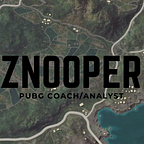Gen.G — Part 2
A well-rounded routine
In Monday’s article, we’ve highlighted Gen.G flexibility. As a matter of fact, the team has played several loot spots throughout the tournament while being the most consistent team so far.
We’ve also determined that the reason behind this successful playstyle is related not only to the amount of preparatory work but also to solid fundamentals they’re able to use consistently.
In this article, we’ll have a more technical approach to PUBG and understand the keys of their gameplay and answer the following questions: How do they manage to maintain such high performance? What are the keys elements to their style?
Step 1: Starting phase
Even if it might be obvious, the reason behind their constant loot spot changes is the necessity to have resources to execute their game plan properly. In other words, they try to start every game with a similar situation:
- Staying alive: Except for the games where they could play the loot spot they’ve prepared, they constantly picked the less risky option. They didn’t contest a single loot spot or a single vehicle, and whenever they have a doubt, they’ve decided to run away.
No matter the price to pay, Gen.G gives a lot more value being four men up than anything else.
- Priority: Whenever they’re allowed to claim a central position, they’ll deliberately accept to play with fewer resources for a strong group of compounds.
- Stuff: When the priority isn’t an option, the team will give a lot of importance to have a complete setup in terms of weapons, attachments, heals, boosts and grenades. Except for Esther, you’ll rarely find the team with anything but fully equipped weapons, good scopes, a suitable amount of heals, boosts, and grenades. It’s indeed a situation every team will be aiming for. However, Gen.G is willing to give up a lot of tempo to ensure they’ll have an inventory complete enough to carry them until the late game.
- Tempo: Last but not least, they don’t give a lot of importance to priority overall (except for an uncontested central position). The only recurrent behavior is one player going to a crucial advanced location to hear potential rotations and start gathering information (how many teams, which side do they play the circle from, how crowded is the entry point we’re aiming for). This player loots small compounds near to the closest team and/or main rotation path. Guess what? This player is Esther 90% of the time.
To sum up, we’ve identified Gen.G starts every game with:
- Securing their life,
- Opt: If given uncontested priority, they’ll give up loot for a central position,
- Make sure everybody is equipped well, except for Esther,
- Concede any tempo and priority but make sure to have a good enough knowledge of the side they plan to approach the first circle from.
Step 2: Early game, mid-game, and transition to late-game
Scenario 1
Whenever Gen.G is already in circle 1, they’ll usually hold a close split (3/1 or 2/2) along a rotation path.
This kind of positioning provides safety: they guarantee mutual protection from each part of the split. If they’re forced into a fight or a crash, they can answer the aggression promptly, not to mention the natural crossfire.
This kind of positioning also provides opportunities: sticking to a primary rotation path creates situations where you’re able to grab extra points at the expense of negligent teams.
Finally, it allows them to rotate easily and exploit a favorable shift with no delay if necessary.
In general, Gen.G will stick to this initial position until they are forced out by the next shift. They won’t try to relocate, reducing the risk of getting caught moving. Instead, they will slowly gather information about the environment and prepare to transition to late-game (identify teams around them, anticipate how things will play out, collect pieces of information, or recognize a positional advantage).
Scenario 2
Whenever Gen.G isn’t in circle 1, they’ll usually take it really slow. Other than Esther’s first approach, they’ll mostly sit on an edge, gathering information to evaluate the circle dynamic.
They’ll make sure to keep a lot of freedom for future circles and stay far away from any form of soft lock. They give a lot of importance to have smooth rotations during phases 2 to 4 to find the best approach possible to what is likely to be the ending area.
From there, they’ll usually adopt a very traditional edge playstyle: control their side and build as much control as possible. However, and unlike other edge teams, it’s way more important for them to stay four alive, and they’re not afraid to play stacked to avoid unnecessary fights.
Regarding the transition to late-game, they will take isolated fights they have high chances to win thanks to near-perfect information and number advantage.
Conclusion
One could easily describe Gen.G as an edge team but this would be a shortcut.
On closer inspection, they indeed prefer to play their back against the blue, and they’re willing to wait for several phases to get to that situation. However, they’re much more methodical than most teams playing a similar playstyle.
They rely on a sum of small advantages meticulously accumulated throughout the game to ensure an excellent endgame. This also explains their consistent performances in WWCD format.
This playstyle finds its limits in your ability to transition properly from mid to late-game. Indeed, a single mistake can quickly change your potential win into a zero-point game. That’s what we’ll be looking at in the 3rd part coming on Friday.
Maxime “Znooper” GONY
